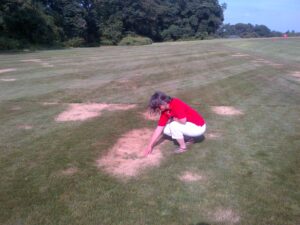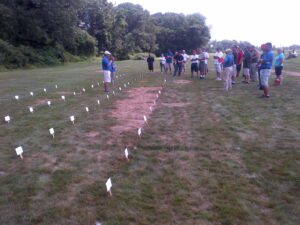Main Content
I have seen as much disease damage on turf this summer as any year since I began living and working in New Jersey (1991).

The hot humid weather has been ideal for summer patch and brown patch diseases.
I have observed more damage from summer patch disease on hard fescue turf than Kentucky bluegrass this year. This is likely due to the fact that more people are growing varieties of Kentucky bluegrass with better tolerance to this disease than was the case 20 or more years ago.
The Rutgers turfgrass breeding program is working on improving the tolerance of hard fescue to summer patch disease.
There are some cultural techniques that can reduce the severity of summer patch disease including:
- Fertilize at no more than 1 lbs. of N per 1,000 sq. ft. per application and 2 lbs. annually)
- Use an acidifying N source (for example, ammonium sulfate)
- Reduce soil compaction (aerify)
- Maintain a slightly acidic soil pH (around 6.0); do NOT lime until pH reaches mid to low 5’s and do NOT attempt to increase the soil pH much above 6.0
- Use seed mixtures (rather than blends) that include tolerant species when seeding hard fescue or Kentucky bluegrass as a major component of the turf. Hard fescue and Kentucky bluegrass (depends on the variety) are sensitive to summer patch.
- Seed with tolerant species which includes tall fescues, perennial ryegrass, and Chewings fescue. Chewings fescue can be damaged by summer patch disease but it is more tolerant than hard fescue as you can see in the image below.

The URLs below will open PowerPoints on summer patch disease prepared by Dr. Bruce Clarke.
/research/diseasecontrolseminar/patchdiseases.pdf
/research/connecticut/summerpatch.pdf